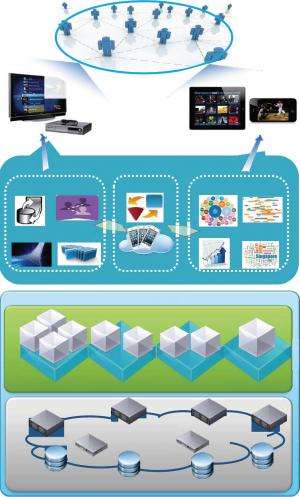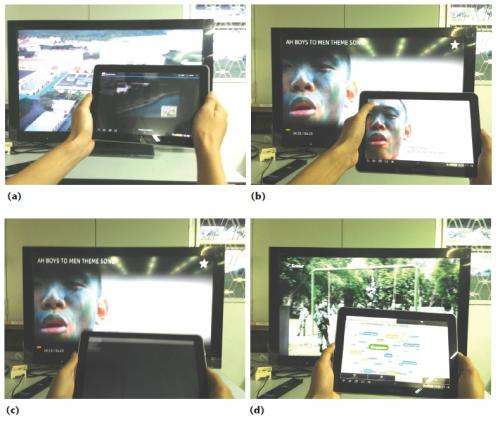September 11, 2014 feature
Multiscreen social TV would enrich traditional viewing experience

Following the trend of the merging of TV and Internet, researchers have proposed a new way to interact with people over the Internet while watching TV. The new paradigm involves using a second screen (such as a tablet or phone) to synchronize with the TV and integrate with geolocation social media—in particular, tweets and other microblogs that relate to the TV program.
The team of researchers, led by Dr. Yonggang Wen at Nanyang Technological University, have published a paper on the new multiscreen social TV method in a recent issue of IEEE MultiMedia.
Although there are other methods that do similar things, one big advantage of the new method is that it is very easy to use. In contrast to a similar technology that requires users to visit a webpage and log on, the new method simply involves using a tablet or phone to take a screen shot of the TV to capture a code, and then performing a quick flip gesture to trigger the transmission process. While the first method takes an average of 40 seconds to orchestrate, the new screen shot method takes an average of less than 5 seconds.
After synchronization, a wide variety of features can be viewed on the tablet or phone screen to accompany the TV show. A "social sense subsystem" crawls social media data associated with the TV show and provides related social discussions. This content comes from social networks such as Twitter, Google+ and Facebook, as well as other sources of geosocial and group-watching functionalities. Relevant content is identified by crawlers that search for keywords, key users, and manually selected known accounts, such as a TV program's official account.
Some of the challenges involved in implementing this new technology include efficiently distributing the very large amounts of user-generated content in order to minimize bandwidth consumption. According to the researchers, addressing this challenge requires using optimization strategies to balance the data transmission and costs. The large amounts of data can also be distributed by a "cloud clone" to fetch, transcode, and synchronize media content.

The research hints at some of the features of future TV viewing, while enabling users to simultaneously engage in other activities without interrupting their TV shows.
More information: Han Hu, et al. "Toward Multiscreen Social TV with Geolocation-Aware Social Sense." IEEE MultiMedia. DOI: 10.1109/MMUL.2014.2
© 2014 Phys.org

















